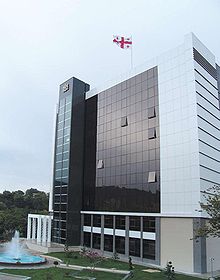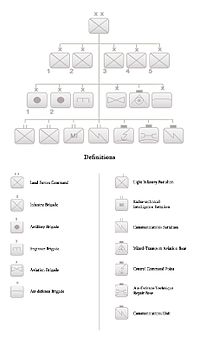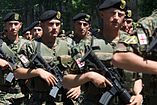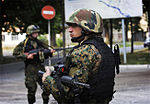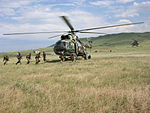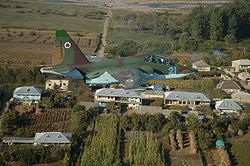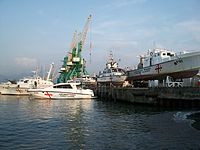- Georgian Armed Forces
-
Not to be confused with Army of Georgia.
Georgian Armed Forces
საქართველოს შეიარაღებული ძალები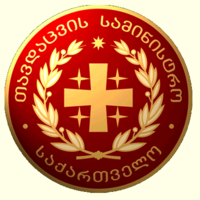
Ministry of Defense of Georgia logoFounded Early 1990s Current form 1991 Service branches Georgian Land Forces
Georgian Special Forces
Georgian Air Force
Georgian Coast Guard
Georgian National GuardHeadquarters Tbilisi Leadership Supreme Commander-in-chief President Mikheil Saakashvili Minister of Defense Bacho Akhalaia Chief of Joint Staff Major General Devi Chankotadze Manpower Military age 18-30 years old Conscription 18 years of age, 18 months Available for
military service2,038,736, age 18-35 (2011 est.) Fit for
military service827,281, age 18-35 (2011 est.) Reaching military
age annually56,965 (2011 est.) Active personnel 57,000. ( 37,000 regular army, 20.000 professional reserve army )[1] Reserve personnel 14 conscript divisions.
~ 140,000 men in total[1]Deployed personnel  Afghanistan - 200 instructor, logistics, and command, and 724 combat personnel[2]
Afghanistan - 200 instructor, logistics, and command, and 724 combat personnel[2]Expenditures Budget 660,000,000 GEL (2011) 1,148,623,900 GEL (2012) [3]
(425,247,876 USD) (2011) (800,075,566 USD) (2012)Percent of GDP 4% (2011)[4] Industry Domestic suppliers Tbilisi Aircraft Manufacturing Foreign suppliers  United States
United States
 Israel
Israel
 Turkey
Turkey
 Czech Republic
Czech Republic
 Germany
Germany
 United Kingdom
United Kingdom
 Ukraine
Ukraine
 Poland
Poland
 Bulgaria
Bulgaria
 Hungary
Hungary
 Greece
Greece
 Latvia
Latvia
 France
France
 Romania
Romania
 Lithuania
Lithuania
 Estonia
EstoniaRelated articles History Russian-Georgian War 2008
War in Abkhazia (1992–1993)
1991–1992 South Ossetia War
Georgia Civil War
Russian-Georgian War 1921Ranks Georgian military ranks The Georgian Armed Forces (Georgian: საქართველოს შეიარაღებული ძალები Sak’art’velos Sheiaraghebuli Dzalebi), is the name of the unified armed forces of Georgia. The Georgian military is a defence force consisting of the Georgian Land Forces, Georgian Air Force and a paramilitary organization Georgian National Guard. The national defence policy aims which are based on the Constitution of Georgia are to guarantee the preservation of the independence and sovereignty of the state and the integrity of its land area, territorial waters and airspace and its constitutional order. The armed forces of Georgia are performed under the authority of the Georgian Ministry of Defense.
Contents
History
The GAF were established in the early 1990s from former Soviet Army units on Georgian soil, irregular militias, and Georgian personnel returning from other posts within the former Soviet Armed Forces.
On March 23, 1994, Georgia was one of the first former Soviet Republics to join the Partnership for Peace. Among the Partners Georgia was the first country who could submit the special documentation (May 2004) and on October 29, 2004 the North Atlantic Council approved the first Individual Partnership Action Plan (IPAP) for Georgia. If the IPAP is successful, Georgia will have good opportunity to accede to the Membership Action Plan (MAP).
Ministry of Defense headquarters in Tbilisi
The Georgia Train and Equip Program (GTEP) training was conducted using U.S. Special Operations Forces and U. S. Marine Corps forces from May 2002 to May 2004. During this time approximately 2,600 Georgian soldiers, including a headquarters staff element and 5 tactical units, received training. Another assistance program, the Georgia Security and Stability Operations Program (Georgia SSOP), was launched in January 2005 as a continuation of the (GTEP) of 2002-2004. Georgian contingents were involved in the Kosovo Force and continue to participate in the operations in Iraq and Afghanistan.
The GAF have been extensively reformed in the recent years to meet Georgia’s aspirations to join NATO and for better response to the existing challenges such as the ongoing tensions in the unresolved separatist conflict areas in Abkhazia and South Ossetia as well as to the threats of global terrorism. Georgia also views a large-scale foreign invasion and the spillover of conflicts from Russia’s North Caucasus as the worst potential near- and long-term scenarios, respectively.[5]
On August 8, 2008 the Georgian military conducted an operation in Georgia's breakaway region South Ossetia (see 2008 South Ossetia War). The operation led to an armed conflict with forces from the Russian Federation and resulted in the defeat and expulsion of Georgian forces from South Ossetia and Abkhazia. Following the military operations, Russia recognized independence of the regions, declared a decade ago.
The military budget of Georgia increased more than 50 times over the period from 2002 (US$ 18 mln.) to 2007 (US$ 780 mln.), reaching over 7% of Georgia's GDP. The military budget was then doubled to the end of 2008 and currently since February 2009, counts 660 mln lari (US$ 366 mln.)
20th century
Main articles: Georgian–Armenian War 1918, Red Army invasion of Georgia, Georgian–Ossetian conflict (1918–1920), 1991–1992 South Ossetia War, War in Abkhazia (1992–1993), and War in Abkhazia (1998)21st century
Main article: 2008 South Ossetia warIn August 2008, following a series of fierce clashes in South Ossetia, Georgia attempted to take the separatist territory by force. In the resulting military conflict with Russia, Georgia was driven out of South Ossetia and Abkhazia, and lost parts of its military capabilities. According to Defense Minister Davit Kezerashvili, Georgia lost $250 million of material worth. Russian forces confiscated a total of 1,728 firearms.[citation needed] Out of its original 200 T-72 tanks, more than 35 were lost, including 24 that were captured intact. A total of 50 pieces of military equipment were captured, and some others destroyed. Parts of Georgia's relatively modern artillery and anti-aircraft units were captured and later destroyed. Russian forces sank four Georgian naval vessels in the port of Poti, a coast guard gunboat in a naval skirmish, and hauled away nine rigid-hull inflatable boats. The Georgian Air Force lost two L-29 jet trainers, one AN-2 airplane, and four helicopters, all destroyed on the ground. Despite these mostly non combat losses, President Mikheil Saakashvili claimed that Georgia had lost less than 5% of its military hardware capabilities, disagreeing on Georgian military figures.[6]
Reconstruction
Georgia immediately began a process of re-armament after the war. The conflict was immediately followed by a very quick replenishment program of the gaps in the single GAF arms components with an additional massive re-equipment and modernization program. Two Georgian naval vessels sunk in Poti were raised and returned to service, although one had to undergo repairs.[7] Georgia also purchased patrol/fast attack boats from Turkey, although their heaviest armaments were 25-30mm cannons. The Georgian Navy's remaining operational naval units were merged into the Georgian Coast Guard, which received training in search and seizure tactics from the United States. Ukraine delivered munitions and artillery systems to Georgia in September 2008,[8] and later supplied Georgia with 12 T-84 and 10 T-72 tanks, three BTR-80 armored personnel carriers, sixty portable air defense missiles, munitions for rocket launchers, and anti-tank guided missiles.[9] Ukraine continued to supply shipments of arms to Georgia, and announced that it would only stop if the United Nations Security Council imposed an arms embargo. Turkey sold Georgia 75 armored personnel carriers, firearms, ammunition, military vehicles, telecommunications systems, and Pakistani-made missiles.[10] Israel supplied Georgia with firearms after the war. The United States also delivered large amounts of arms and military equipment to Georgia after the war, and trained Georgian personnel.[11] Israel sold Georgia numerous Unmanned aerial vehicles, and Turkey supplied Georgia with two helicopters. The United States also trained Georgian soldiers to be deployed in Afghanistan. Georgia also rebuilt its damaged military bases. In August 2010, Georgia was reported to be spending 30 times more on its military budget than on economic development.[12] By late 2010 the Georgian military had reached a strength greater than pre-war levels and, after completing the reforms, decisively reduced military spending.[13]
Organization
The current authorized strength of the GAF structures is 36,553 personnel, including, 21 high ranking officers, 6,166 officers and sergeants, 28,477 corporals, 125 cadets and around 388 civilians.[1] The Georgian Parliament aims to increase the professional strength of the ground forces till 2011.[14] The Georgian legislation (17 December 2010) establishes the strength of armed forces at no more than 37,000 for the year 2011. This limitation does not extend to the state of war, military reserve and temporary staff of the Defense Ministry of Georgia.[15]
- Georgian Land Forces
- National Guard of Georgia
The Land Forces form the largest component of the GAF responsible for providing land defense against any threat to the nation’s sovereignty and territorial integrity, supporting Border Police in border protection and civil authorities in counter-terrorist operations as well as providing units for NATO-led and coalition operations abroad. They are organized into infantry brigades, artillery and other supporting capacities operating at a battalion level.[16]
The Air Force consists of aviation and air defense assets and provides security to Georgia’s airspace, while the Georgian Navy protects Georgia’s territorial waters and contributes to the collective maritime defense in the Black Sea region. The Special Force Brigade is responsible for conducting reconnaissance, unconventional warfare and counter-terrorism operations. The Georgian National Guard organizes and trains reservists in the peacetime and mobilizes them during a crisis or wartime.[16]
Ground Arms
The structure of the Georgian Land Forces is based on brigade and battalion sized military units. The main operational regular force consists of five infantry and two artillery brigades. Separate battalions are: the Light Infantry Battalion, one Engineer Battalion, one Air-Defense Battalion, one Signal Battalion, one Technical Reconnaissance Battalion, two Anti-Tank Battalions and one Medical Battalion. The Army Brigades consist of several battalions and companies having a manpower of up to 5.500+ each including non-combat personnel.[17] The overall strength of Land Forces is 36,553 (excluding reserve forces) from which 21 are high ranking officers, 6,166 officers and sergeants, 28,477 corporals, 125 Cadets and 388 civilians.[1] The ground arm is equipped with various weapons systems and vehicles (see here). Special Forces units and Counter Terrorism sections are separated to the Ministry of Defence and Ministry of Interior headquarters. The Georgian Land Force consists of following combat formations (incomplete) :[18]
Regular Forces
- Army HQ, Land Forces Command (Tbilisi)
- Central Command Point
- Mixed-Transport Aviation Base
- Air-Defence Technique Repair Base
- Communications Unit
 1st Infantry Brigade (Gori)
1st Infantry Brigade (Gori)
- 11th Telavi Light Infantry Battalion
- 12th Light Infantry Battalion
- 13th "Shavnabada" Light Infantry Battalion
- 14th Light Infantry Battalion
- 15th Light Infantry Battalion
- One Anti Tank Battalion, one Motorized Rifle Battalion, two Mechanized Battalions, one Reconnaissance Battalion, one Mountain Combat Section
- 2nd Infantry Brigade (Senaki)
- 21st Light Infantry Battalion
- 22nd Light Infantry Battalion
- 23rd Light Infantry Battalion
- 24th Light Infantry Battalion
- 25th Light Infantry Battalion
- One Anti Tank Battalion, two Motorized Infantry Battalions, one Mechanized Battalion, one Air-Support squadron, one Air-Combat group, one Air-Defence section, two Reconnaissance platoons
 3rd Infantry Brigade (The Mamelukes) (Kutaisi)
3rd Infantry Brigade (The Mamelukes) (Kutaisi)
- 31st Light Infantry Battalion
- 32nd Light Infantry Battalion - deployed in Helmand Province, Afghanistan[19]
- 33rd Light Infantry Battalion - currently replacing the 32nd Battalion in Afghanistan
- 34th Light Infantry Battalion
- 35th Light Infantry Battalion
- One Anti Tank Battalion, one Motorized Infantry Battalion, one Armoured Battalion, one Signal Battalion, one Air-transport wing, one Engineer Battalion, one heavy artillery support cadre.
 4th Infantry Brigade (Vaziani)
4th Infantry Brigade (Vaziani)
- 41st Light Infantry Battalion
- 42nd Light Infantry Battalion
- 43rd Light Infantry Battalion
- 44th Light Infantry Battalion
- 45th Light Infantry Battalion
- Two Anti Tank Battalions, Two Mechanized Battalion, one Air-transport wing, one Air-support squadron, one Reconnaissance and Surveillance Battalion.
- 5th Infantry Brigade (Khelvachauri and Khoni)
- 51st Light Infantry Battalion
- 52nd Light Infantry Battalion
- 53rd Light Infantry Battalion
- 54th Light Infantry Battalion
- 55th Light Infantry Battalion
- One Mountain Battalion, One Air-transport wing, two Tank Battalions, one Mechanized Battalion, two Motorized Rifle Battalions, two Anti-Air Battalions
- Separate Formations
- The Engineer Brigade, the Aviation Brigade, the Air Defence Brigade (Kutaisi), the Separate Tank Battalion (Gori), the 1st separate Anti-Tank Battalion (Gori), the 2nd separate Anti-Tank Battalion, the Separate Light Infantry Battalion (Adlia), the Separate Pioneer Battalion (Saguramo), the Separate Technical Reconnaissance Battalion (Kobuleti), the separate Communications Battalion and the Medical Regiment (Saguramo)
 1st Artillery Brigade (Vaziani)[20]
1st Artillery Brigade (Vaziani)[20]
- 2S7 Pion batteries
- LAR-160 batteries
- BM-21 batteries
- RM-70 batteries
- SO-152 batteries
- 152mm SpGH DANA batteries
- 152 mm gun 2A36 heavy howitzer batteries
- 152 mm howitzer 2A65 medium howitzer batteries
- D-30 light howitzer batteries
- D-48 antitank gun batteries
- 2B11 mortar platoons
- M43 mortar platoons
- Two Anti Air Battalions, two Infantry Battalions and reconnaissance-surveillance companies.
 2nd Artillery Brigade (Khoni)
2nd Artillery Brigade (Khoni)
- 2S7 Pion batteries
- BM-21 batteries
- RM-70 batteries
- SO-152 batteries
- 152mm SpGH DANA batteries
- 152 mm gun 2A36 heavy howitzer batteries
- 152 mm howitzer 2A65 medium howitzer batteries
- D-30 light howitzer batteries
- MT-12 anti tank gun batteries
- 2B11 mortar platoons
- M43 mortar platoons
- Two Anti Air Battalions, two Infantry Battalions and reconnaissance-surveillance companies.
Special Forces
- Army HQ, Special Operations Main Division (Tbilisi)
 Special Forces Brigade
Special Forces Brigade
- Vashlijvari Special Operations Center
- Naval Warfare Center
- Rapid Response Battalion
- Air Assault Group Mobile
- Special Reconnaissance Detachment Alpha
Georgian Special Forces are subordinated under the MOD Special Operations Main Division to a brigade-level command structure. Each formation is split into several sub-divisions which are allocated on different Georgian regions, cities and strategically important areas. Most units are composed of veterans of past conflicts including the Soviet Invasion of Afghanistan, the wars in Georgia and the insurgency in Chechnya. Some soldiers served in former Soviet Army formations in Russia and the Ukraine.
Since 2001, Georgia has intensified the training of its elite forces in cooperation with American, French, British, Israeli and other countries' special services. Georgian commandos participated in the Iraq War from 2003 until the complete withdrawal of the Georgian contingent in 2008 due to an escalation of hostilities in South Ossetia. According to independent accounts, a number of Georgian operatives were also deployed prior in Afghanistan to aide US Special Forces in hunting down Taliban leaders. Georgian officials have stated that a group of servicemen were deployed in Afghanistan for medical purposes.
In the very first hours of the 2008 South Ossetia War, Georgian special forces backed by artillery successfully eliminated armed opposition around the city of Tskhinvali as a prerequisite for the full-scale ground assault which followed shortly after in the morning of August 8. The Georgian military then announced that more than 11 villages in South Ossetia were under control of government forces. However the Georgian military would ultimately be pushed back out of South Ossetia following Russian intervention in the conflict.
Following the reversal, the bulk of Georgian special forces assisted Interior Ministry units in the evacuation of ethnic Georgians and VIPs out of South Ossetia. Sergeant Kakhaber Tavgorashvili died in the morning of August 8 in the course of fighting, the only member of Georgia's special forces to be killed in action to date.[21] Around 55 were reported with injuries of different degrees.[22] Special Forces followed the general withdrawal order but set up key points very close to Russian forces at towns like Igoeti and Gori.
Army Air Section (former Air Force)
Georgian Sukhoi Su-25 ground attack aircraft Main article: Georgian Air Force
Main article: Georgian Air ForceThe Georgian Air Force was merged into the Army in 2010, and was renamed the Army Air Section, undergoing massive reorganization and restructuring. The additional operative section of the Georgian Land Forces currently consists of an unknown amount of planes, transport helicopters, gunships and 3,000 Personnel. The Georgian Air Force lost two helicopters on ground during the 2008 South Ossetia War,
Two major airfields are located near Tbilisi at Alekseevka and Marneuli.
Main article: Georgian NavyThe Georgian Navy was abolished in 2009 and was incorporated into the Coast Guard, which is not structurally part of the Georgian Armed Forces, but rather it is a subunit of the Border Guard of Georgia, which is under the control of Ministry of Internal Affairs of Georgia. The Coast Guard of Georgia is responsible for maintenance of the sovereignty of the country and for protection of internal territorial waters and economic zones. The headquarters and a principal Coast Guard base are located at the Black Sea port of Poti.
The other, smaller Coast Guard base is in Batumi. Besides the naval force, the navy also includes a Special Counter-terrorist Detachment force. Georgia is also one of the founding members and a participant of the Black Sea Naval Co-operation Task Group. Before the war with Russia, the Georgian navy had 19 naval vessels. 4 of them were sunk during the conflict, and nine rigid-hull inflatables were captured by Russia. The Georgians raised and returned to service two of the sunken vessels, and partially replaced their losses with Turkish-built patrol/fast attack boats. Their heaviest armaments are 25-30mm cannons. However, no Georgian navy vessels are armed with ship-to-ship missiles.
National Guard of Georgia
The National Guard of Georgia was established on December 20, 1990 and was manned by volunteers. It represents the first Georgian armed formation, which became the base of the foundation for modern Georgian Armed Forces. The Guard actively participated in the conflicts that occurred in Georgian territory (Samachablo, Abkhazia).
The National Guard used to consist of 20,554 personnel, but has now been reduced to 550. The main missions of the National Guard are:
- Support civil government in crisis situations (natural, technological, ecological);
- Register mobilization resources, study and deliver;
- Convene, select and man of citizens on the basis of the agreement, for the units, subunits and bases of the Armed Forces;
- Provide ceremonial activity support;
- Assisting in training the Reserve Forces.
Reserve Army and People's Reserve
The Georgian Reserve Army is organized and commanded by Land Forces, the National Guard Department of Georgia and consist of following formations:(incomplete)
10th Cadre Brigade (Kojori)
20th Cadre Brigade (Senaki)
30th Cadre Brigade (Mukhrovani)
50th Cadre Brigade (Telavi)Active Cadre Brigades are being properly trained and prepared for emergency and wartime situations by the National Guard and the Land Forces. The professional main core of the Reserve Forces in times of crisis and war consists of five active and fully operational Cadre Brigades with additional regional division headquarters. These combat formations consisting of only volunteers will reinforce the regular army in its activities when short on personnel or even directly support engagements.
Further on, the so called "Rally Points" of the regional divisional headquarters allow the Georgian government to mobilize and arm national reserve units of division strength in a matter of days if a war brakes out. Approximately around 100.000 citizens of Georgia would be mobilized in such a case. The in comparison to the Land Forces and National Guard rather poorly equipped reserve has not much access to mobility providing options like armour and in general tracked or wheeled vehicles, but trucks. In addition, there is also a limited choice of small arms, mostly of soviet origin. The National Guard department guarantees adequate supply of equipment and arms if the situation affords it, including uniformsm, ballistic vests and equipement. The uniforms are customarily identical with those of the Land Forces. Reserve units may have access to the few still operational T-55AM2 medium tanks of the pre-1990-2005 Georgian Army.
List of weapons used by the Reserve as of 2007:
International cooperation
Georgian Armed Forces have been participating in peacekeeping missions (the Balkans, Persian Gulf) since 1999.
Units participating in peacekeeping missions are manned by professional soldiers, the duration of the mission is six months and participation is voluntary. The readiness assessment criteria are, as follows: health condition, physical fitness, professional skills and experience.
Peacekeeping missions
About 200 Georgian troops were deployed in the Kosovo (KFOR) in 1999-2008, 70 were deployed in Iraq (OIF) in 2003 and 50 in Afghanistan in 2004 (ISAF). From 2004 in Iraq were 300 Georgian troops. From 2005 approximately 850 troops were serving under Coalition Command (OIF and UNAMI). On July 2007 Georgia sent an extra 1,400 troops to Iraq; that brought the total number of troops in Iraq to 2,000. On August 8, 2008 Georgia announced it will withdraw 1,000 troops from Iraq due to rising hostilities with Russia. Their preparedness and training skills are evaluated on highest level by international experts. The entire Iraq contingent has been airlifted back to Georgia.
Hence, owing to participation in international peacekeeping missions the military members are able to obtain practical experience and to show readiness to cooperate with NATO and with other partner countries' forces.
Currently there are more than 975 Georgian combat troops deployed in Helmand, Afghanistan where Georgia has thus far suffered 10 deaths and 38 injuries.[23][24]
Bases
Name Location Ministry of Defense Headquarters Tbilisi Vaziani Military Base near Tbilisi Krtsanisi Military Base near Tbilisi Akhalkalaki Military Base Akhalkalaki Alekseevka Airbase near Tbilisi Marneuli Airbase Marneuli Bolnisi Airbase near Tbilisi Gori Military Base near Gori Senaki Military Base Senaki Poti naval base Poti Mukhrovani Military Base Mukhrovani Kutaisi Military Base Kutaisi Khelvachauri Military Base Khelvachauri Khoni Military Base Khoni Batumi naval base Batumi See also
- Georgia and NATO
References
- ^ a b c d http://milkavkaz.net/?q=node/8
- ^ http://mod.gov.ge/index.php?page=77&lang=1&type=1&Id=597
- ^ http://mod.gov.ge/index.php?page=-10&Id=10&lang=1
- ^ http://www.civil.ge/eng/article.php?id=22067
- ^ The Strategic Defense Review (2007), p. 77.
- ^ http://www.webcitation.org/5jZjEpcOy
- ^ http://www.flickr.com/photos/gavinsblog/2909836113/sizes/m/in/set-72157607708120897/
- ^ http://www.rt.com/Top_News/2008-11-03/Ukraine-continues-to-arm-georgia_.html
- ^ http://www.rt.com/Top_News/2009-10-08/ukraine-arms-trade-georgia.html
- ^ http://www.rt.com/Politics/2009-04-01/Turkey_arms_Georgia.html
- ^ http://www.foxnews.com/story/0,2933,419682,00.html
- ^ $400 mln on guns, $12 mln on economy: Saakashvili's spending plan RT on YouTube
- ^ http://www.russianpeacekeeper.com/en/index.php?mid=11854
- ^ http://mod.gov.ge/index.php?page=1&lang=1
- ^ (Georgian) საქართველოს სამხედრო ძალების რაოდენობის დამტკიცების შესახებ. Parliament of Georgia. December 17, 2010. Accessed April 12, 2011
- ^ a b The Strategic Defense Review (2007), p. 74.
- ^ http://www.mod.gov.ge/index.php?page=-10&Id=25&lang=1 Structure of Land Forces
- ^ Georgian Ministry of Defence: Land Force
- ^ http://www.usmc.mil/unit/marforeur/Pages/CeremonymarksdeploymentofsecondGeorgianbattaliontoAfghanistan.aspx
- ^ Saakashvili visits new base of artillery brigade. Interfax. Retrieved on December 4, 2009
- ^ http://mod.gov.ge/index.php?page=-10&Id=31&lang=1
- ^ http://www.kommersant.ru/Doc/1600839
- ^ Tenth Georgia Soldier Killed in Afghanistan Retrieved: September 1, 2011
- ^ Seth Robson. "U.S. training a dual mission for Georgians". Stripes.com. http://www.stripes.com/news/u-s-training-a-dual-mission-for-georgians-1.136920. Retrieved 2011-06-13.
 This article incorporates public domain material from websites or documents of the United States Department of State (Background Notes). 2005
This article incorporates public domain material from websites or documents of the United States Department of State (Background Notes). 2005  This article incorporates public domain material from the CIA World Factbook document "2005 edition".
This article incorporates public domain material from the CIA World Factbook document "2005 edition".External links
- Ministry of Defense of Georgia: The Strategic Defence Review 2007. mod.gov.ge. Accessed on May 7, 2008.
- GlobalSecurity.org on Georgia’s military
- Ministry of the defence of Georgia: Armed Forces of Georgia. Accessed on March 6, 2009.
- Military Heraldry of Georgian Armed Forces.
Military of Europe Sovereign
states- Albania
- Andorra
- Armenia
- Austria
- Azerbaijan
- Belarus
- Belgium
- Bosnia and Herzegovina
- Bulgaria
- Croatia
- Cyprus
- Czech Republic
- Denmark
- Estonia
- Finland
- France
- Georgia
- Germany
- Greece
- Hungary
- Iceland
- Ireland
- Italy
- Kazakhstan
- Latvia
- Liechtenstein
- Lithuania
- Luxembourg
- Macedonia
- Malta
- Moldova
- Monaco
- Montenegro
- Netherlands
- Norway
- Poland
- Portugal
- Romania
- Russia
- San Marino
- Serbia
- Slovakia
- Slovenia
- Spain
- Sweden
- Switzerland
- Turkey
- Ukraine
- United Kingdom
- Vatican City
States with limited
recognition- Abkhazia
- Kosovo
- Nagorno-Karabakh
- Northern Cyprus
- South Ossetia
- Transnistria
Other entities - European Union
- Sovereign Military Order of Malta
Categories:- Military of Georgia (country)
- Conscript militaries
Wikimedia Foundation. 2010.

